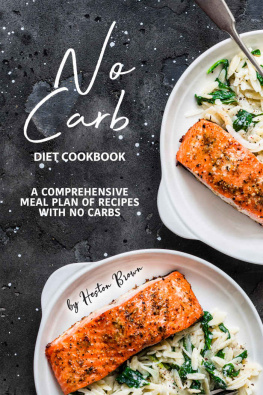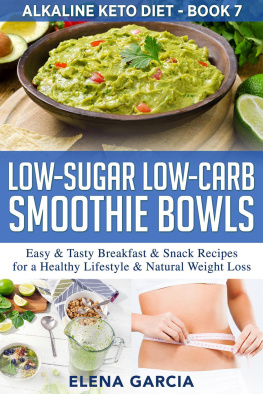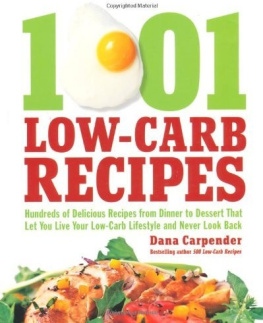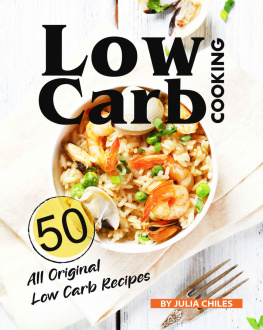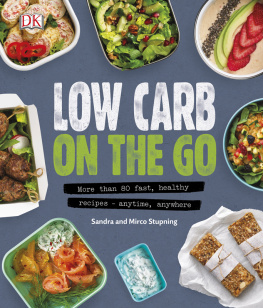A LSO BY D ONNA P LINER R ODNITZKY

Ultimate Smoothies
Summer Smoothies
Slim Smoothies
Tipsy Smoothies
The Ultimate Low-Carb
Diet Cookbook
Ultimate Juicing
Sinful Smoothies

Its impossible to express in words
the appreciation and admiration
I have for my husband,
Bob. He has been my rock
for more than thirty-five years.
It is because of his encouragement and
continuous belief in all my endeavors
that I have been able to write
Low-Carb Smoothies as well as my other cookbooks.
My wonderful children,
David, Adam, and Laura,
continue to astound me with their
wit, character, adventuresome spirit,
and pursuit of excellence.
They are an inspiration
for me always to aim higher.

Acknowledgments
I WOULD LIKE TO THANK my editor, Caroline Sincerbeaux, who has been a joy to work with this past year. I have been impressed with her relentless enthusiasm, insightful suggestions, and extraordinary eye for detail. My gratitude also goes to Karen Minster for designing such a beautiful book, and to the entire staff at Three Rivers Press for their excellent professionalism in bringing this book to publication.

CONTENTS
The Skinny on Low-Carb Diets
Whats It All About?
Fruit for Thought
Low-Carb Smoothie Ingredients
Getting Up to Speed.
All Youll Ever Need to Know to Prepare a Low-Carb Smoothie
Simple Pleasures
BASIC LOW-CARB FAVORITES
Ultra Low-Carb (6 grams or less)
Low-Carb (10 grams or less)
Frosty and Fortified
PUMPED-UP SMOOTHIES FOR YOUR HEALTH
Ultra Low-Carb (8 grams or less)
Low-Carb (12 grams or less)
Maintenance Low-Carb Smoothies
NOW THAT YOUVE TAKEN IT OFF, KEEP IT OFF!
Ultra Low-Carb (12 grams or less)
Low-Carb (15 grams or less)
The Garnish Factor
How to Embellish a Low-Carb Smoothie
Mail-Order and Online Shopping
Where to Get Low-Carb Ingredients
 Introduction
IntroductionA diet is the penalty we pay for exceeding the feed limit.
ANONYMOUS

IN THE 1970S, DR. ROBERT C. ATKINS PUBLISHED the book Dr. Atkins Diet Revolution. This book revolutionized the way millions of people dieted. Instead of encouraging us to restrict the amount of fat in our diet as most diet experts stressed at that time, Dr. Atkins told us to focus on reducing the daily intake of refined carbohydrates. He was convinced that dietary carbohydrates were the main culprit in causing people to gain weight, largely because carbohydrate-laden foods such as sugars and starches cause the body to increase the production of insulin, a hormone that promotes fat accumulation in the body.
While most people credit Dr. Atkins for introducing the low-carb diet, this way of eating can actually be traced back to England in the 1860s. It began with the dietary dilemma of an undertaker named William Banting, who was 5 feet 5 inches tall and weighed 202 pounds. Because of this excessive weight he couldnt bend over, and any exertion left him exhausted. Since obesity was rare at that time, he was subject to public ridicule. His doctors suggested diuretics and Turkish baths, but by the time he was sixty-six years old, he had resigned himself to the belief that he would be obese until the day he died.
His fate changed when his physician returned from a seminar on diabetes that suggested a high-protein, low-carbohydrate diet, usually recommended for diabetics, might also have an effect on obesity. Mr. Banting was told to eliminate bread, potatoes, beer, milk, sugar, and butter from his daily meal plan. While he continued to eat his customary four meals a day, he followed the diet and successfully lost forty-six pounds in less than a year. Banting was so elated with his success that he wanted to share it with the public. He wrote and distributed a twenty-two-page pamphlet entitled Letter on Corpulence that warned against eating foods that contained sugar and starch. Because of the immediate and overwhelmingly positive response to the first thousand copies of his publication, he printed and sold another fifty thousand. Not surprisingly, the medical community immediately attacked the diet and criticized it for not being studied to their satisfaction (sound familiar?). Mr. Banting, for his part, went on to live to be eighty-one years old in his newly slimmed state.
The popularity of Mr. Bantings diet lasted only a few years. It was later replaced by other diets, such as Fletcherism (slow eating) and Phtoline (the use of a purgative), to name just a few. Unlike fleetingingly popular previous diets, though, the Atkins diet has continued to grow in acceptance, both by the medical community and the general population. Several other plans have also been published similarly promoting low-carbohydrate intake, such as the South Beach Diet, Sugar Busters, the Carbohydrate Addict, the Zone, and Protein Power. Each emphasizes the need to restrict carbohydrates in the diet, but individual authors offer a slightly different approach to the original Atkins concept.
As popular and effective as these diets are, many low-carb enthusiasts find it difficult to completely give up all the wonderfully satisfying foods and beverages they enjoyed in the past. Unfortunately, a sweet tooth cant be extracted by the dentist. One of the ways many of us enjoyed satisfying our sugar-loving incisors in 2005 B.C . (Before Carbs) was with a rich and syrupy smoothie. These mellow concoctions, made from the tantalizing union of fruit and fruit juice, are easy to prepare, inherently flavorful, and even provide significant health benefits. However, as tasty and healthful as your favorite traditional smoothies may be, they are almost certainly not carb-friendly. Unfortunately, traditional smoothie ingredients such as fruits, fruit juice, most yogurts, ice cream, and other dairy products contain unacceptably high amounts of carbohydrates.
The good news is that I have overcome this obstacle. Today, with the amazing low-carb recipes found in this book, you can actually splurge on a flavorful smoothie without losing ground in the battle of the bulge. Get ready to discover in these pages that smoothies, when properly prepared, can be reinvented as a low-carb indulgence that is sweet and satisfying. By simply choosing only carb-friendly fruit, substituting zero-or low-carb ingredients, and adding a variety of sugar-free flavor enhancements, you can create a wonder-in-a-glass that is low-carb legal, yet amazingly rewarding in taste.


